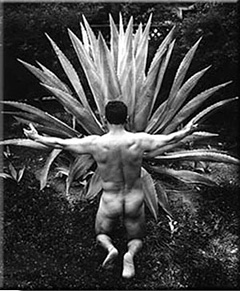
|  |  |  Entertainment | Restaurants & Dining Entertainment | Restaurants & Dining  
Mexico's Tequila Refines Its Act
 Joe Ray – Agence France-Presse Joe Ray – Agence France-Presse
go to original
December 21, 2010


| Paying Reverence to Tequila

Mayahuel, the Aztec goddess, produced from her breast from the first alcoholic drink of the Americas.

Called pulque, this spirited beverage gave rise to mezcal and tequila, Mexico’s national drink.

Like their country of denomination, the history of these libations reflect the turbulent growth of Mexico herself.

Originating in the indigenous populations, transformed by foreign invasions, and finally building identities of their own after a revolution, the offspring of pulque are emerging as the world’s greatest new spirits.

Although mezcal and tequila have been the most under-appreciated and misunderstood spirits on the market, this past decade may well be tequila’s golden age, an era of enlightenment. (Janaap Dekker) |  |
Tequila, Mexico – The truck trundled through Mexico's tequila country, its trailer crammed with trimmed heads of agave plants, as a troupe of elaborately-dressed dancers performed for visitors in a nearby distillery.

At one point the main protagonist, Mayahuel, the Mayan goddess of fertility, thrust her arms skyward, eyes wide.

Just underneath her sequined skirt, peeking out on the top of her underwear, were two words however that revealed this was a very modern take on an ancient ceremony: Calvin Klein.

In central Mexico where tequila is produced, there is an odd mix of timeless inspiring beauty and more recent modernization. Rolling fields are filled with the blue-green spiked leaves of the agave plant, against a backdrop of western movie-worthy buttes and canyons.

Tour guides give a glimpse of the most scenic parts of old factories but, as the industry grows, many distilleries now resemble mammoth refineries, as they push to create a more consistent, economical process.

What has kept tequila on the radar of many connoisseurs over the years is a steady rise in quality.

The rotgut that has given generations of college students hangover horror stories is as popular as ever, but much recent industry growth comes from the push for something that can compete with high-end scotch or cognac.

The last decade has seen an explosion of growth for tequila made entirely of blue agave instead of agave mixed with cane sugar - the potentially hangover inducing so-called "mixto" brands.

According to the National Chamber of the Tequila Industry, total mixto export - the historical industry backbone - dropped 3.1 percent between 2008 and 2009.

But industry exports grew 5.1 percent overall, most notably 100 percent blue agave tequila, which increased 3.3 percent over the same period and has grown more than 300 percent since 2000.

The largest export market is the United States, and according to figures from Euromonitor some 11.3 million cases of tequila were sold in the US in 2009, bringing in a total of 476.5 million dollars.

Many tequilas are now aged in oak barrels, while the newest trend is using old bourbon, sherry or cognac casks to add nuance and suppleness to something once as subtle as the spiked end of the agave leaf.

There are also signs of a trickle down effect, with high-end quality tequila beginning to show up at mid-range prices.

Mules and horses which traditionally hauled harvested agave and pulled giant stone wheels used to crush the cooked leaves have been replaced by machines. In some cases, the wheel itself has been relegated to a museum.

"We were using wooden fermenting tanks but they leaked, they were hard to clean and had wild organisms in the wood," said Jesus Hernandez, master distiller at Casa Pedro Domencq in Arandas. "It was just a source of aggravation."

Yet in the push to mechanize, they also realized some advantages of the historic process.

"We tried using a diffuser but you lose flavors," said Hernandez, describing a machine that treats the raw agave more like tea than the traditional oven cooking method. "We abandoned the idea."

Meanwhile, Francisco Hajnall Alfaro, director general of the Mexican Academy of Tequila Tasters and "Master Tequilero" for the Cuervo distillery, described removing what he called the "bitter bones" from the agave plant by cutting the distilled heart closer to the core, which also however trims profits.

"Otherwise," he said, "it reminds your stomach and your mouth of a bad time."

In the fields, mechanization only goes so far. Agave plants are still harvested by "jimadores" or harvesters - men of few words and sharp tools who prefer life outdoors.

Liborio Acevez is a third generation, rough-handed jimador who heads a team of 16, including his son, Juan Antonio. They work for Agaveros Morales, one of the agave suppliers to the high-end Patron brand.

"On my team, I have four brothers and three cousins. The rest are friends, but I'm the boss," he said with a chuckle.

He avoids romanticizing the work. He likes the extra money of being a jimador compared to the work of an agave porter, and is proud that his son is out there with him.

How long will he keep doing it?

"Until I can't."

Two hours away, in the town of Tequila, in a tiny dive known informally as La Capilla - the chapel - Javier Delgado, 87, a tequila barrel cooper turned bar owner puts the spirit into perspective.

Though La Capilla is said to be the birthplace of the salty-rimmed "paloma," a tequila, lime and grapefruit soda mix that is Mexico's favorite tequila drink, Delgado insists the bar is a humble canteen and he is not familiar with cocktails.

"I'm happy that people like tequila, but it's more important that they come here and feel happy and content," he said. "The drink is not the important part." |

 |
|  |



